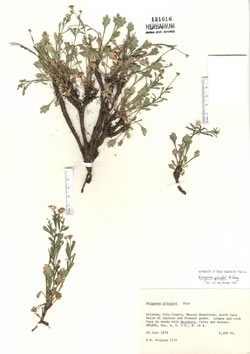How Pringle’s Fleabane Lost Its Leaf Lobes
…and Became Three New Species
 This pressed specimen of Pringle’s fleabane (Erigeron pringlei) shows the pinnatifid basal leaves that characterize the species. Photo by Desert Botanical Garden Herbarium at swbiodiversity.org.
This pressed specimen of Pringle’s fleabane (Erigeron pringlei) shows the pinnatifid basal leaves that characterize the species. Photo by Desert Botanical Garden Herbarium at swbiodiversity.org.
 The flowers of rock fleabane (Erigeron saxatilis) are fairly typical for a member of the fleabane group. Photo by Max Licher at swbiodiversity.org.
The flowers of rock fleabane (Erigeron saxatilis) are fairly typical for a member of the fleabane group. Photo by Max Licher at swbiodiversity.org.
 Rock fleabane is very much like Pringle’s fleabane in growth habit, but its basal leaves are linear to spathulate rather than pinnatifid. Photo by Max Licher at swbiodiversity.org.
Rock fleabane is very much like Pringle’s fleabane in growth habit, but its basal leaves are linear to spathulate rather than pinnatifid. Photo by Max Licher at swbiodiversity.org.
 Heliograph Peak fleabane (Erigeron heliographis) is the most restricted of these fleabanes. It is found in a very small part of the Sky Island Pinaleno Mountains. Its leaves are linear and the whole plant is very compact. Photo from Arizona Rare Plant Field Guide, 2001.
Heliograph Peak fleabane (Erigeron heliographis) is the most restricted of these fleabanes. It is found in a very small part of the Sky Island Pinaleno Mountains. Its leaves are linear and the whole plant is very compact. Photo from Arizona Rare Plant Field Guide, 2001.
The fleabanes (genus Erigeron) are a large group of plants in the Sunflower family. There are about 170 species in North America and 390 species worldwide. Many species are quite similar and can only be distinguished using very technical characters.
Dr. Guy Nesom is an expert on this plant group. He wrote the treatment for the fleabanes that now appears in Flora of North America, Volume 20 (2006). While studying specimens of Pringle’s fleabane (Erigeron pringlei), a species that grows only in Arizona, he found some specimens that did not quite fit. Most of the specimens had lobed basal leaves with the lobes arranged in a way that botanists call pinnatifid. A few specimens, however, had basal leaves without any lobes. These basal leaves were either linear or somewhat spade-shaped (spathulate). He arranged the specimens into groups based on their leaf shapes and a few other more technical characters and ended up with four different groups.
He then began looking at the geographic distribution of the specimens. He found that standard Pringle’s fleabane with its pinnatifid leaves had the broadest distribution occurring from north-central Arizona to the far southeastern corner of the state. The other three groups of specimens had far narrower distributions. One was found in canyons above the Mogollon Rim south of Flagstaff, one was found only in the Sierra Ancha Mountains northeast of Phoenix, and one was found only in a small part of the Pinaleno Mountains in southeastern Arizona.
Each group of plants is distinct and distinguishable from the other groups, and each has its own unique distribution that does not overlap with any of the other groups. These are the ingredients most botanists consider sufficient to recognize a group of plants as a distinct species. Nesom named his new fleabanes Erigeron saxatilis (rock fleabane), Erigeron anchana (Sierra Ancha fleabane), and Erigeron heliographis (Heliograph Peak fleabane). It appears these three new species all evolved from Pringle’s fleabane through the process of migration, isolation, and adaptation with this all happening as a result of the warming climate and the isolating effect of Sky Island mountain ranges.
Further Reading
- Nesom, Guy L. 1990. Taxonomy of the Erigeron pringlei group (Asteraceae: Astereae). Phytologia 69(3):227-235.
- Critically Imperiled Plant Profile: Erigeron heliographis, Heliograph Peak fleabane

